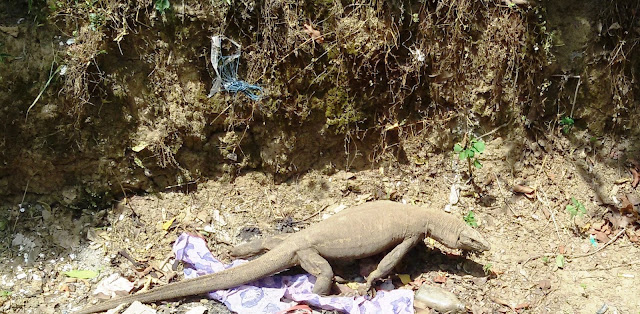 |
| Monitor lizard at my Backyard |
Coh tend to swallow their prey whole like snakes. They are daytime lizards and most time actively search for food. They have a forked tongue. The function is mainly sensory, and is not help in the transport of food down the throat. Coh are carnivorous and eat small terrestrial vertebrates, birds, eggs and also includes frogs, fish, other small lizards, snakes and rodents. They sum times feed on dead animals also. They often visit on dung near cow shelter ( Goshalas/Shann in Bandrai ) where they forage for beetles and other insects.
They
are not territorial and may change their range seasonally in response to food
availability. They can also swim well and can stay submerged for at least 15 to
16 minutes in water. Coh also love to take mud bath in summer session for
keeping their body cool. During winter session they may take shelter in the
tree hollows or in human settlement area and go through a period of reduced
metabolic activity.The
main breeding season is June to September. Females dig a nest hole in level
ground or a vertical bank and lay the eggs inside. They also make use of
termite mound. The eggs are covered by soil with the help of strong powerful
limbs.They
are usually shy and avoid humans. But Coh in our village area widely hunted by Sansi and Shikligar
tribes, they are specialized in killing them, Sansi people comes from Punjab in Bandrai for hunting they eat Coh
meat. They dig there deep barrows and kill them, these tribes still use old
ways of hunting. These lizard falls under schedule I of the wildlife protection
Act 1972 and killing or trapping it is a non-bailable offence. Coh are killed
for their meat and skins. These are threatened species.







Cool shot Vjay. Thats an impressive lizard.
ReplyDeleteA great write up too. Nice work.
it is good that people like you are working for such cause. Specially for the en-dangerous species. And exploring the village in far flung area of jammu and kashmir .
ReplyDeleteGood Keep it Up
thank you.....
ReplyDeleteexcellent work , very less people in jammu and kashmir are that much aware of this beautiful creature , most of the people here think its more venomous than snakes,.......
ReplyDeleteIt looks like a common Bengal Monitor (Varanus bengalinensis) to me. They're wide spread over India to south east asia. They have one subspecies, which looks very similar, called Clouded Monitor (V. b. nebulosus)
ReplyDeleteNice...
ReplyDeleteIts really awesome sir... Such a valuable knowledge
ReplyDeleteSalute to your passion
ReplyDeleteNice bro
ReplyDelete